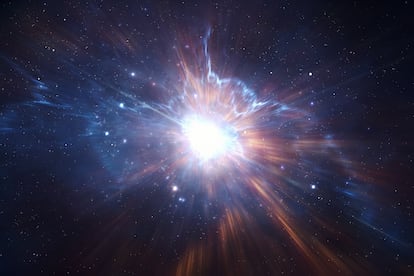The ingredients of the universe were chosen in three minutes
Our knowledge of physics — gained through astrophysical experiments, or in laboratories via machines such as particle accelerators — is sufficient to know what happened in the first three minutes of the universe, where everything we see today was forged

Obviously, as a scientist — and, more specifically, as an astrophysicist — I cannot say anything else: astrology is a scam. The stars don’t influence our lives or our destinies. And, as a “classical physicist,” I’m convinced that science is deterministic. Physical laws govern the cosmos, hence we can understand the behavior of any system if we know these laws well, while taking into account the initial conditions and collecting the appropriate data.
If I were a more modern physicist — a quantum physicist, let’s say — I would then have to consider the deterministic limitations linked to a certain chance, as well as the implications of chaos theory.
The first three minutes of the universe determined the current composition of the universe, along with all of its subsequent evolution. In other words, what we are today — everything that exists, everything that will exist, everything that does not exist and will not exist — was decided in just three minutes! These are the elements of destiny, on a cosmic scale.
And what happened in those first three minutes of our universe? Obviously, the answer isn’t as easy as that question seems to indicate. There are several aspects to this. Here, I will discuss just three of them.
The first problem has to do with the definition of the “first minutes” of the universe. We astrophysicists — along with anyone who likes cosmology — often reiterate that the universe is about 14-billion-years-old. The most accurate estimate is currently 13.787 billion years, plus or minus 20 million years. This statement implies that there’s an origin of time, which would be the Big Bang.
The question might arise — and some may laugh at it, but it’s far from being silly, because there are no silly questions — about what happened before, or whether time can be negative. But the point is that the Big Bang is the origin of time itself. Time is created, or — to avoid getting into theological issues — it appears (as we know it and live it today) in the Big Bang. So, the destiny of the universe was created in the first three minutes of the existence not only of the universe, but of time itself.
What exists if time doesn’t exist? I don’t know how to answer that question.
Another aspect to take into account in order to answer the question about the first three minutes of our universe is that everything we see around us — the universe we call “observable,” which extends right now from the screen where you’re reading this article to the most distant galaxy we know — was concentrated three minutes after the Big Bang in an extremely small volume, between a quadrillionth and a quintillionth of what it occupies today. It’s as if a person were the size of a single atom.
“The entire universe” wasn’t just limited to that volume, there would be much more nearby in those early epochs of the universe. But those other parts of the universe are today too far away and we have no information about them. We often say that “we’re not connected to them,” beyond thinking that this unreachable universe is the same as ours, the observable one.
With that size, the universe had a much higher density, as well as a much higher temperature. This means that the baby universe of the past was very different from the one we know today. But (and this is key) the temperature of the universe during the first second after the Big Bang up to the third minute of life went from about a hundred billion degrees to just a billion degrees… the latter number a few dozen times above the temperature of the Sun’s core.
Scientists have been able to reproduce and study this dramatic range of temperatures in a laboratory. Specifically, in the Large Hadron Collider (LHC), temperatures to the order of five trillion degrees have been reached, or more than 10 times above the temperature of the universe in the first second of the Big Bang. As a result, we know pretty well what happens in the first three minutes of the universe forming.
Before those 180 seconds were complete, what dominated the energy of the universe were particles that seem normal to us today: electrons, neutrinos, photons — as well as their antiparticles — along with protons and neutrons, whose antiparticles had already disappeared from the universe (at least from the one we currently live in). Before that first second, however, it wasn’t like that: there were other, more complicated particles that we still don’t know so well.
Our knowledge of physics today — based on laboratory work — is sufficient to know how all those particles that dominated the energy of the expanding universe behaved. The universe was increasingly larger, colder and rarefied (that is, less dense). In a way, analogous to how the gas in a cloud cools down and how water — or even ice — forms, the entire universe went through changes of state as it cooled down. But the analogy isn’t perfect, because at the same time that the cosmos was becoming less dense, the space-time fabric was getting bigger. The result was that, initially — in the one second after the Big Bang — all the aforementioned particles were interacting with each other, with electrons colliding with positrons and creating photons, or photons colliding with other photons (which are their antiparticles) and giving rise to neutrinos and antineutrinos. Also these were colliding with protons and forming neutrons, or vice versa. And, by the time the third minute was reached, all those interactions disappeared.
The rate of expansion and cooling of the universe in those three minutes precipitated the events. First, the neutrinos stopped being in equilibrium with the other normal particles: neutrinos and anti-neutrinos annihilated each other (except for a small portion) and those that survived began to travel freely. Today, it’s still extremely difficult to stop a neutrino by making it interact with a proton or an electron; calculations indicate that you need a light-year of lead to achieve an interaction (and the interstellar medium in a light-year around us is quadrillion times less dense than lead). Traveling freely means that they stopped interacting with protons and neutrons, which can transform into each other in the presence of sufficiently energetic neutrinos and antineutrinos. But that stopped happening a couple of seconds after the Big Bang: the number of protons and neutrons were suddenly frozen.
Shortly after that — not a long time for us, but we’re talking about right after the Big Bang, when the age of the universe was doubling every second — positrons and electrons also stopped being in balance. They self-annihilated, with only a few surviving. From then on, there were only photons, protons, neutrons, electrons and neutrinos in the universe. All the normal matter was already in place. From then on, its evolution began to go its own way, which would eventually end in the creation of stars, followed by planets (or maybe at the same time, in the case of gaseous planets).
In between all of this, let me not forget to mention that there was another type of matter that had been going its own way for a long time — that is, long before the first second — without interacting with photons and other particles, except for the effect of gravity. I am referring to dark matter, which had already planted the seed of galaxy formation and which — in the future — would dominate the energy of the universe, before dominance was taken over entirely by something else.
And all this, don’t forget, happened in just three minutes.
Sign up for our weekly newsletter to get more English-language news coverage from EL PAÍS USA Edition
Tu suscripción se está usando en otro dispositivo
¿Quieres añadir otro usuario a tu suscripción?
Si continúas leyendo en este dispositivo, no se podrá leer en el otro.
FlechaTu suscripción se está usando en otro dispositivo y solo puedes acceder a EL PAÍS desde un dispositivo a la vez.
Si quieres compartir tu cuenta, cambia tu suscripción a la modalidad Premium, así podrás añadir otro usuario. Cada uno accederá con su propia cuenta de email, lo que os permitirá personalizar vuestra experiencia en EL PAÍS.
¿Tienes una suscripción de empresa? Accede aquí para contratar más cuentas.
En el caso de no saber quién está usando tu cuenta, te recomendamos cambiar tu contraseña aquí.
Si decides continuar compartiendo tu cuenta, este mensaje se mostrará en tu dispositivo y en el de la otra persona que está usando tu cuenta de forma indefinida, afectando a tu experiencia de lectura. Puedes consultar aquí los términos y condiciones de la suscripción digital.
More information
Archived In
Últimas noticias
Most viewed
- David King, chemist: ‘There are scientists studying how to cool the planet; nobody should stop these experiments from happening’
- Reinhard Genzel, Nobel laureate in physics: ‘One-minute videos will never give you the truth’
- Mexico completes its trade shift with the entry into force of tariffs on China and countries without trade agreements
- Oona Chaplin: ‘I told James Cameron that I was living in a treehouse and starting a permaculture project with a friend’
- Sinaloa Cartel war is taking its toll on Los Chapitos











































